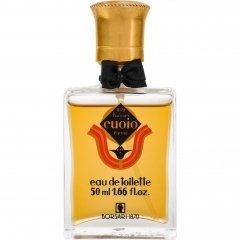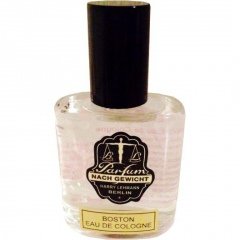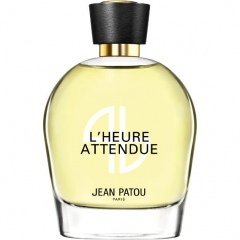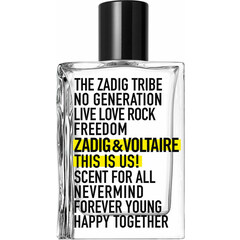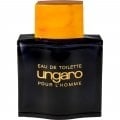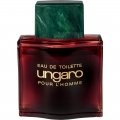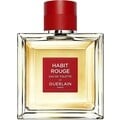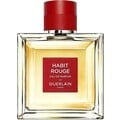
MonsieurTest
Reviews
Filter & sort
Translated
Show original
The soft scent of dictatorships
1933 was a good year. Only a parfumo can think, write and publish such an insane sentence. And he can only mean this, if he is morally sane, from a perfume-historical point of view. 1933 was not the only year in which this wonderfully soft, mildly spicy leather fragrance appeared. In the year in which the Nazis seized power in Germany in January, Guerlain's 'Sous le Vent' and 'Vol de Nuit', Caron's 'Fleur de Rocaille', Houbigant's 'Présence', Lanvin's 'Scandal', moreover, Patou's 'Divine Folie' and Weil's 'Secret de Venus' saw the dim light, or nearer: the noses of the world; in Spain, moreover, Myrurgia's 'Embrujo de Sevilla' and the still-available, delightfully refreshing, gentle cheap cologne 'Gotas de Ora'.
In Germany, 'Mousons Lavendel' and Sir Cologne by 4711 appeared in the year the Weimar Republic died and Nazi terror took over, and in all the aforementioned countries beyond that, some lesser-known, previously extinct fragrances, as our excellent Parfumo database reveals to the history-conscious perfumer at a few clicks. The history year of horror was thus the birth of numerous fragrance classics, a large proportion of which - from Guerlain's 'Sous le Vent' to the Borsari leather fine fragrance to be honoured here - are now sadly extinct.
What else happened then, and what was far more important than the appearance of this extraordinary array of great fragrances that managed to last a long time, is traced by Uwe Wittstock's recently published book 'February 1933' primarily through the lives of important writers in those weeks of massive upheaval and political horror.
In Italy, of course, Mussolini's Fascists had already been at the helm since 1922, first as part of a centre-right coalition, then from 1925 onwards by means of ever further abolition of parliamentary rules of the game with dictatorial powers. Life for many people, especially for the Jewish population of Italy, however, only became worse and more unbearable in the course of the 1930s, also promoted by the fascist seizures of power in Germany, and later still in Franco's Spain.
In the midst of these ugly and, for many of those affected, ghastly times, many a luxury good nevertheless also flourished. As mentioned, some of the most beautiful classic modern fragrances were created throughout Europe at that time. And 'Cuio' by Borsari may well be counted among them. It is really impressive how, on a base of vetiver and sandalwood, an accord of soft, very slightly human-smelling leather is recreated here, which warmly envelops a heart of sandalwood. A kinship to the 8 years older Knize Ten is not to be denied; whereby the Borsari leather comes across softer and finer.
Presumably, birch tar aroma is also processed here as a classic leather note. And the whole thing is rounded off with the traditionally masculine notes of tobacco, patchouli and minimal animalic musk. Despite the usual force of pretty much all the fragrance components involved, the concert of these heavyweights here seems rather light and floating, rather buttery than aggressively radiating.
Yes, yes, this perfume smells a little old-fashioned; but in the best sense, that is: elegant, noble, natural. As well as: completely rounded. One would rather not imagine how it was worn with brown or black uniforms and leather boots in the use of higher cadres in the criminal attacks and state actions in 1933 and in the following years.
Today this exquisite 'Cuio' is apparently no longer available. What for friends of well-composed fragrances from wholly classic ingredients all times a loss means. 'Cuio' by Borsari allows one to wander through time. It evokes leaps of thought and trips down memory lane.
It had its origins in the most fatal and dark times of this country - as well as of its country of origin, Italy. Yet even in such adverse, evil times, beauty could miraculously flourish.
My heartfelt thanks goes to the dear Parfumo colleague killer bee for his filling of this and many other classic fragrances!
In Germany, 'Mousons Lavendel' and Sir Cologne by 4711 appeared in the year the Weimar Republic died and Nazi terror took over, and in all the aforementioned countries beyond that, some lesser-known, previously extinct fragrances, as our excellent Parfumo database reveals to the history-conscious perfumer at a few clicks. The history year of horror was thus the birth of numerous fragrance classics, a large proportion of which - from Guerlain's 'Sous le Vent' to the Borsari leather fine fragrance to be honoured here - are now sadly extinct.
What else happened then, and what was far more important than the appearance of this extraordinary array of great fragrances that managed to last a long time, is traced by Uwe Wittstock's recently published book 'February 1933' primarily through the lives of important writers in those weeks of massive upheaval and political horror.
In Italy, of course, Mussolini's Fascists had already been at the helm since 1922, first as part of a centre-right coalition, then from 1925 onwards by means of ever further abolition of parliamentary rules of the game with dictatorial powers. Life for many people, especially for the Jewish population of Italy, however, only became worse and more unbearable in the course of the 1930s, also promoted by the fascist seizures of power in Germany, and later still in Franco's Spain.
In the midst of these ugly and, for many of those affected, ghastly times, many a luxury good nevertheless also flourished. As mentioned, some of the most beautiful classic modern fragrances were created throughout Europe at that time. And 'Cuio' by Borsari may well be counted among them. It is really impressive how, on a base of vetiver and sandalwood, an accord of soft, very slightly human-smelling leather is recreated here, which warmly envelops a heart of sandalwood. A kinship to the 8 years older Knize Ten is not to be denied; whereby the Borsari leather comes across softer and finer.
Presumably, birch tar aroma is also processed here as a classic leather note. And the whole thing is rounded off with the traditionally masculine notes of tobacco, patchouli and minimal animalic musk. Despite the usual force of pretty much all the fragrance components involved, the concert of these heavyweights here seems rather light and floating, rather buttery than aggressively radiating.
Yes, yes, this perfume smells a little old-fashioned; but in the best sense, that is: elegant, noble, natural. As well as: completely rounded. One would rather not imagine how it was worn with brown or black uniforms and leather boots in the use of higher cadres in the criminal attacks and state actions in 1933 and in the following years.
Today this exquisite 'Cuio' is apparently no longer available. What for friends of well-composed fragrances from wholly classic ingredients all times a loss means. 'Cuio' by Borsari allows one to wander through time. It evokes leaps of thought and trips down memory lane.
It had its origins in the most fatal and dark times of this country - as well as of its country of origin, Italy. Yet even in such adverse, evil times, beauty could miraculously flourish.
My heartfelt thanks goes to the dear Parfumo colleague killer bee for his filling of this and many other classic fragrances!
33 Comments
Translated
Show original
Ode to Orange. Song to the loam man
Orange. Almighty come down from the ether ...
To thy temple. Once built by Harry.
Back on Kantstrasse in West Berlin.
Where they bring scent offerings for the Parfumos.
Brew today still the cooling Colognes themselves
Quite without incense.
Juicy orange drips here. With green stuff shaded.
The tree all in, and even a little of earth.
That full of bliss, as soon as I briskly besplase, I catch freshness.
Over there. There in the meadow friends are frolicking.
Fumbling in the clover and in the ripening ears.
Sweet smells ohn flowers waft from the meadow
Here to me.
Goddess of the citric! Receive my bouquet of flowers.
Come and appear to us. Fill the orange bowls.
Mix thy freshness with greenwood and give us a
Heavenly joy.
------------
What Sappho breathed into me here as a muse, wants to say
Harry (or: Lutz) Lehmann has brewed a wonderfully orangy fresh cologne with 'Boston'; underpinned with green, woody and earthy notes. It actually feels, due to its tendency to unrefined rawness, as if simply (and the simple is known to be the hardest in art...) an orange grove with branches, stem and stump is being processed here. With style!
Sillage and durability remain colognetypisch moderate: few Handbreit it radiates and pleases us few hours.
The whole fits more in the rural or domestic garden-like area. It does not seem over-polished. At the same time it seems to me quite today, urban and understatement cool. Rather Berlin than Munich, I think.
It seems a little retro, but that's good.
(My thanks for inspiration and verse goes to the olle Sappho and her "Ode to Aphrodite"!)
To thy temple. Once built by Harry.
Back on Kantstrasse in West Berlin.
Where they bring scent offerings for the Parfumos.
Brew today still the cooling Colognes themselves
Quite without incense.
Juicy orange drips here. With green stuff shaded.
The tree all in, and even a little of earth.
That full of bliss, as soon as I briskly besplase, I catch freshness.
Over there. There in the meadow friends are frolicking.
Fumbling in the clover and in the ripening ears.
Sweet smells ohn flowers waft from the meadow
Here to me.
Goddess of the citric! Receive my bouquet of flowers.
Come and appear to us. Fill the orange bowls.
Mix thy freshness with greenwood and give us a
Heavenly joy.
------------
What Sappho breathed into me here as a muse, wants to say
Harry (or: Lutz) Lehmann has brewed a wonderfully orangy fresh cologne with 'Boston'; underpinned with green, woody and earthy notes. It actually feels, due to its tendency to unrefined rawness, as if simply (and the simple is known to be the hardest in art...) an orange grove with branches, stem and stump is being processed here. With style!
Sillage and durability remain colognetypisch moderate: few Handbreit it radiates and pleases us few hours.
The whole fits more in the rural or domestic garden-like area. It does not seem over-polished. At the same time it seems to me quite today, urban and understatement cool. Rather Berlin than Munich, I think.
It seems a little retro, but that's good.
(My thanks for inspiration and verse goes to the olle Sappho and her "Ode to Aphrodite"!)
33 Comments
Translated
Show original
The longed-for moment - the dreaded hour. Stele for Patou
No one picks, distills and composes such beautiful bouquets of flowers as Patou. That's my impression as a - unfortunately late..., too late! - stumbled upon some Patou perfumes. Soft, buttery-framed, delicate florals. Roses, jasmine, osmanthussis far from any headache hints. Wonderful little flowers, bound in creamy bases.
Nothing pungent.
Soft round pleasantness.
Sheer delight.
So the impressions of my Vernasungen of Sublime, Joy, Mille etc. as well as the here to praise / deplore 'L'Heure attendue'.
'The awaited hour' is the name of this enchanting perfume. A little more pathetic and translated with melting: the longed-for moment. The perfume was first composed after the end of World War 2 by Henri Alméras, the house perfumer Jean Patou during three decades. It was launched in 1946. The longed-for moment celebrated here was the liberation of France, the end of war, occupation, Nazi terror. And that, if Thomas Fontaine's recomposition of the wonderful, slightly 'brown' chypres, the only one I know of, comes close to the original, was celebrated in this deliciously gentle perfume in the most delicate, soft, not at all loudly triumphant way imaginable.
This longed-for moment begins with a delightful, very slightly tart opening, into which I associate (if disaggregations are at all meaningful and possible in Fontaine's ingenious art of blending) with florals as if under a brown aldehyde-neroli butter interspersed with hints of gently spicy patchouli. This longed-for moment continues with a sunny smile as the dreamy toned, never garish Patou flowers, here a subdued jubilant trio of rose, jasmine and ylang-ylang, spill into the heart.
And the anticipated hour fades out for hours on a gorgeous accord of civilly hedged patchouli alongside sandalwood and traces of spicy ambers. If you're a Guerlain fan, you think highly of the Guerlinade, that soft-spicy, gorgeously oscillating, pearlescent base accord with its great reverberant sequences. L'Heure attendue by Patou offers something very similar... and thus possibly not only in its name a salute to the great mother ship of French perfume art, Guerlain. Whose fragrance at the end of the First World War was Mitsouko (1919), and whose fascinating fragrance 'L'Heure bleue', rather akin to the one under review here, saw the evening light of Paris and the world in 1912, before the Grande Guerre.
'L'Heure attendue', at least in Thomas Fontaine's beautiful 2015 version is - like the 'L'Heure bleue' I cherish - a quiet fragrance: despite its florals, at most a stuffed trumpet. In a way, an anti-Shalimar.
In the first hour, before everything becomes wonderfully soft, creamy delicate and incredibly round, I sense a very gently animalic, dirty middle voice that gives the fine floral concerto a spicy, yet harmonious overtone. I suspect it is based on an artful blend of aldehydes with amber and patchouli notes. It is, however, miles away from the powerfully animalic civet of a Jicky or the massive smoke-balsam vanilla of Shalimar.
This fragrance, like its predecessor the 1946 original, flies strangely low under the radar at Parfumo. There is no commentary on the original of 'L'Heure attendue' and just one statement; on the reconstruction of Thomas Fontaine, this is the first commentary, after several statements by very knowledgeable Parfumo contributors.
This leads me to believe that the fragrance wasn't particularly widely available even before then. And that, unfortunately, the Patous 2015 heirloom-appreciation action did not attract much attention either. The recent, highly regrettable discontinuation of the Patou brand certainly also points to the lack of commercial success of these fragrances today. Which is very sad for perfume and history buffs.
In 1946, Patou's post-war advertising poster - with sunrise iconography rendered in blue - celebrated the longed-for moment of civilian, of good, of refined luxury after the horrors of war, occupation and fascist terror. Implicitly, it also pointed to the evil preceding years, "Jean Patou's first new perfume in 12 years."
The dreaded hour of the wonderful Collection Heritage Patous, founded only in 2014, came in 2019: the end of the great perfume history of the fashion house of Jean Patous, who died young in 1936. The dreaded hour, when a good perfume rich in history is discontinued, concerned here not only a single fragrance, but at once a good dozen great fragrances scooped by Henry Alméras and by Jean Kerléo, who was the perfume director of the House of Patou from 1967-1998.
Kerléo was co-founder in 1988 and then director for many years of the perfume archive Osmothèque in Versailles. Their main task according to Kerléo is the preservation of fragrance creations, books, formulas and scents for posterity. Also the recreation or re-creation of lost fragrances. No doubt he and his successors will have archived, preserved and researched the fantastic fragrance formulas and perfumes of the House of Patous. So that a return of these recently perished fragrances should be possible in some (nostalgic or just gently luxurious) future. That would be then, for perfume friends, again a 'longed for hour'.
The fate of the Patou brand is probably not entirely atypical of the trade and eventual demise of great fragrance brands. Luxury licensing conglomerate 'Designer Parfums' (owned by India's billionaire Mehta family) acquired the brand in 2011 from Procter and Gamble, who had bought Patou from Jean Patou's heirs in 2001. At Designer Parfumes, the fine luxury house of Patou was now in curious perfume brand company between a revered address like Scherrer, solidly likeable designer fragrance brands like Cerrutti 1881 and Aigner, and the celebrity scents of Jennifer Lopez, Naomi Campbell, Ariana Grande, and finally testosterone brands like Porsche Design and Playboy.
One might have thought that the final takeover of Patou's trademark rights by LVMH (which owns finest perfume houses like Guerlain, Dior, Bulgari, Givenchy and a few more) meant good things, hence a safeguarding of Patou's fragrance heritage. Things turned out differently: Surprisingly, the luxury group revived the long-discontinued Patou fashion brand, but transferred the trademark rights to the name of the most famous Patou fragrance, JOY, to Dior. Where now a completely different smelling JOY is thrown among the people (er: sold expensively). And had the Patou perfume production stopped. Certainly there were solid economic reasons for this (low sales figures of the Patou fragrances and quite expensive production costs etc.). Nevertheless, it is infinitely sad with regard to the admirers of the fine Patou fragrances and to the otherwise so proudly praised French perfume cultural heritage.
With 0.01% of B. Arnault's fortune, the Patou fragrances could easily continue to be made. And with a little imagination, probably market them profitably, would like to call to Paris.
If this will somehow and sometime be heard, and Patou and 'L'Heure attendue' will one day resurrect, then that will be, we suspect, a longed-for hour for perfume history.
My thanks to Barbara R3mt9 for her generous bottlings of this and several other Patou fragrances!
Nothing pungent.
Soft round pleasantness.
Sheer delight.
So the impressions of my Vernasungen of Sublime, Joy, Mille etc. as well as the here to praise / deplore 'L'Heure attendue'.
'The awaited hour' is the name of this enchanting perfume. A little more pathetic and translated with melting: the longed-for moment. The perfume was first composed after the end of World War 2 by Henri Alméras, the house perfumer Jean Patou during three decades. It was launched in 1946. The longed-for moment celebrated here was the liberation of France, the end of war, occupation, Nazi terror. And that, if Thomas Fontaine's recomposition of the wonderful, slightly 'brown' chypres, the only one I know of, comes close to the original, was celebrated in this deliciously gentle perfume in the most delicate, soft, not at all loudly triumphant way imaginable.
This longed-for moment begins with a delightful, very slightly tart opening, into which I associate (if disaggregations are at all meaningful and possible in Fontaine's ingenious art of blending) with florals as if under a brown aldehyde-neroli butter interspersed with hints of gently spicy patchouli. This longed-for moment continues with a sunny smile as the dreamy toned, never garish Patou flowers, here a subdued jubilant trio of rose, jasmine and ylang-ylang, spill into the heart.
And the anticipated hour fades out for hours on a gorgeous accord of civilly hedged patchouli alongside sandalwood and traces of spicy ambers. If you're a Guerlain fan, you think highly of the Guerlinade, that soft-spicy, gorgeously oscillating, pearlescent base accord with its great reverberant sequences. L'Heure attendue by Patou offers something very similar... and thus possibly not only in its name a salute to the great mother ship of French perfume art, Guerlain. Whose fragrance at the end of the First World War was Mitsouko (1919), and whose fascinating fragrance 'L'Heure bleue', rather akin to the one under review here, saw the evening light of Paris and the world in 1912, before the Grande Guerre.
'L'Heure attendue', at least in Thomas Fontaine's beautiful 2015 version is - like the 'L'Heure bleue' I cherish - a quiet fragrance: despite its florals, at most a stuffed trumpet. In a way, an anti-Shalimar.
In the first hour, before everything becomes wonderfully soft, creamy delicate and incredibly round, I sense a very gently animalic, dirty middle voice that gives the fine floral concerto a spicy, yet harmonious overtone. I suspect it is based on an artful blend of aldehydes with amber and patchouli notes. It is, however, miles away from the powerfully animalic civet of a Jicky or the massive smoke-balsam vanilla of Shalimar.
This fragrance, like its predecessor the 1946 original, flies strangely low under the radar at Parfumo. There is no commentary on the original of 'L'Heure attendue' and just one statement; on the reconstruction of Thomas Fontaine, this is the first commentary, after several statements by very knowledgeable Parfumo contributors.
This leads me to believe that the fragrance wasn't particularly widely available even before then. And that, unfortunately, the Patous 2015 heirloom-appreciation action did not attract much attention either. The recent, highly regrettable discontinuation of the Patou brand certainly also points to the lack of commercial success of these fragrances today. Which is very sad for perfume and history buffs.
In 1946, Patou's post-war advertising poster - with sunrise iconography rendered in blue - celebrated the longed-for moment of civilian, of good, of refined luxury after the horrors of war, occupation and fascist terror. Implicitly, it also pointed to the evil preceding years, "Jean Patou's first new perfume in 12 years."
The dreaded hour of the wonderful Collection Heritage Patous, founded only in 2014, came in 2019: the end of the great perfume history of the fashion house of Jean Patous, who died young in 1936. The dreaded hour, when a good perfume rich in history is discontinued, concerned here not only a single fragrance, but at once a good dozen great fragrances scooped by Henry Alméras and by Jean Kerléo, who was the perfume director of the House of Patou from 1967-1998.
Kerléo was co-founder in 1988 and then director for many years of the perfume archive Osmothèque in Versailles. Their main task according to Kerléo is the preservation of fragrance creations, books, formulas and scents for posterity. Also the recreation or re-creation of lost fragrances. No doubt he and his successors will have archived, preserved and researched the fantastic fragrance formulas and perfumes of the House of Patous. So that a return of these recently perished fragrances should be possible in some (nostalgic or just gently luxurious) future. That would be then, for perfume friends, again a 'longed for hour'.
The fate of the Patou brand is probably not entirely atypical of the trade and eventual demise of great fragrance brands. Luxury licensing conglomerate 'Designer Parfums' (owned by India's billionaire Mehta family) acquired the brand in 2011 from Procter and Gamble, who had bought Patou from Jean Patou's heirs in 2001. At Designer Parfumes, the fine luxury house of Patou was now in curious perfume brand company between a revered address like Scherrer, solidly likeable designer fragrance brands like Cerrutti 1881 and Aigner, and the celebrity scents of Jennifer Lopez, Naomi Campbell, Ariana Grande, and finally testosterone brands like Porsche Design and Playboy.
One might have thought that the final takeover of Patou's trademark rights by LVMH (which owns finest perfume houses like Guerlain, Dior, Bulgari, Givenchy and a few more) meant good things, hence a safeguarding of Patou's fragrance heritage. Things turned out differently: Surprisingly, the luxury group revived the long-discontinued Patou fashion brand, but transferred the trademark rights to the name of the most famous Patou fragrance, JOY, to Dior. Where now a completely different smelling JOY is thrown among the people (er: sold expensively). And had the Patou perfume production stopped. Certainly there were solid economic reasons for this (low sales figures of the Patou fragrances and quite expensive production costs etc.). Nevertheless, it is infinitely sad with regard to the admirers of the fine Patou fragrances and to the otherwise so proudly praised French perfume cultural heritage.
With 0.01% of B. Arnault's fortune, the Patou fragrances could easily continue to be made. And with a little imagination, probably market them profitably, would like to call to Paris.
If this will somehow and sometime be heard, and Patou and 'L'Heure attendue' will one day resurrect, then that will be, we suspect, a longed-for hour for perfume history.
My thanks to Barbara R3mt9 for her generous bottlings of this and several other Patou fragrances!
39 Comments
Translated
Show original
Some Day my Prince Will Come. ZigZag, Live
Now there was a break between the sets. Their mood was upbeat, the place was likeable. They had done well with the first 6 songs. The audience went along. Their musician buddies hung on Nika's lips and also a little on her neck. Because she COULD talk. And she smelled good. The drummer and the bass man wanted to know from Nika, their saxophonist, which perfume she was wearing today. Because they only too gladly wanted to be able to sniff their girlfriends also soon so deliciously, if they were after the tour again at home.
In the lively conversation droning of the charmingly furnished living room club, the ZigZag, yes, many thought of curves here too, constantly..., they did not understand the strange fragrance name of the never heard brand. Something with mermaid, which would be in strange stores to buy.
So Nika jumps up, curves to the next table but one, where she had noticed a fine fellow earlier, sometimes beaming sympathetically, sometimes looking melancholy. She asks him for a pen to scribble her band-boy 'Prodischiööh' on her Realbooks.
And so, as she leans down, she also catches a whiff of obsession on the charming guy's neck. And this casually dressed man around 50 was by no means wearing the somewhat more harmless Obsession for Men, but rather the Real Stuff: the EdP that requires a gun license.
Tall and lean he was, chatting so animatedly with his mate. His boyish laugh had caught her eye as she watched the audience from the edge of the stage during his colleagues' solos. When he narrated, he gestured almost southernly with his slender hands. That didn't really fit to such a graceful grey-blond curly hair; as little as this heavy obsession. But such quirkiness had always fascinated her: the blue notes of life.
She had continued to soak up his visual vibes from the musician's table, chatting with colleagues, squinting out of the corners of her eyes. His distinctive scent now too, now! Curious appearance the guy, almost jittery alive, extraordinary somehow, ageless. She liked that sort of thing, so fast in her head that some people couldn't quite keep up, and she hardly ever liked to sit still with her body either. Something was always bothering her. Him, too, apparently.
Her pulse quickened, a warm feeling spreading through her belly. Why on earth had he captivated her so quickly during their concert here?
His lively, shrewdly twinkling eyes now smile directly at her. He nods, hands her his pen (oh dear, a 707, taste he has too), pays her a witty compliment on her imaginative sax solos, praises her powerfully smoky tone - and turns back to his friend.
His Obsession does what it must, and gives her the rest: its sensual, ambery shades of vanilla, its deep, minimally-animalic spiciness make her shiver briefly. I hope the man doesn't notice. It was a little (or more?) about her: such a distinctive guy...- hadn't come her way in a long time.
The second set started, they get on stage and continue their Miles Davis homage. Now it's 'Some day my Prince will come'. The trumpeter plays her intro, then they together in unison the melody and this is followed, as always, by the piano solo. Fred is in a good mood today too. She listens to him absorbed, and her eyes roam over the audience. In a moment it's her turn with her 12 bars on the classic, which Chet Baker and of course Miles had modulated again and again, unforgettably - melancholic and at the same time hopefully driving forward. She starts, she gets going. She blows herself into a frenzy, stretching her solo to 36, eventually 48 bars, and narrating and narrating on her saxophone - in slow motion.
The hushed conversations in the ZigZag Club grow quieter. They finally fall silent altogether as one by one in the audience realizes something special is going on. Dionysus, the pithy Greek behind the bar who not only runs the club but is a passionate drummer, marvels more and more spellbound until tears of emotion roll from his dark eyes.
This guy has a big heart and gets what's being remembered, hoped and dreamed here right now from the saxophone of this stunningly vital, tall woman. Whose curves match those of her saxophone so well, and whose gaze alternates between inward, into memories, and dreamily into the audience. As she plays and plays.
Of course, the band colleagues also notice what a special evening this is about to become, and join in: after their own solos, into which sighing interjections from Nika's saxophone are allowed to flow again and again, they also do it differently than usual during the subsequent Screw Ball, the dialogic trading fours: drums, bass, piano and trumpet always play their four bars alternately to the always new, always different, cheekily varying tempo of Nika's four bars, who is apparently just telling her life.
The band seems to fly, the hall to float away; so many pensive (or: painful?) smiling faces. They've been playing the piece - or rather, with the piece and with their feelings - for 20 minutes now. Absolutely extraordinary it was. As the time went on, one after the other in the band and then in the audience had probably realised that this wasn't going to be their every-evening 10-minute version of 'Prince Come', but that today, here towards the fabulous three-quarters of an hour of Coltrane's 'A Love Supreme' they were fantasising and pining, praying and improvising for life.
.................. ................... ....................
'Obsession' is a fragrance that, even after a good 30 years and a few reformulations, is still able to conjure up some of its seductively sensual qualities on the skin and in life. As was customary in the 1980s, it contains pretty much all the fruits and spices, woods and resins that make up an oriental-inspired erotic. And thereby was honked from full horns, but quite finely composed.
Vanilla is at the center. But here, like the simple Broadway melodies by the great jazz improvisers, she is modulated and played through in all possible keys. It sings its gently sweet melody sometimes mildly fruity (in the opening), sometimes sultry floral or dry cedar and sandalwood in the heart notes, and finally mossy, patchouli and vetivery bassy towards the end. Nuances of incense, musk and a passing civet cat add one or two more delightful choruses to this grandly orchestrated vanilla orgy, giving Obsession an animalic vivacity that is hard to resist.
From sweetly painful melancholic blues to growling free jazz outbursts, you can experience almost anything here, as in Archie Shepp's saxophone eruptions. Such a perfume sharpens the senses, makes you receptive to spices and envelops you in a warmly ambered sexiness that seems adult and indescribably sensual.
For hours, this modern classic projects its spellbinding vibes over two arm's lengths. Earlier was even more force and durability; the current, however, is quite enough for a long, elated or passionate evening.
In the lively conversation droning of the charmingly furnished living room club, the ZigZag, yes, many thought of curves here too, constantly..., they did not understand the strange fragrance name of the never heard brand. Something with mermaid, which would be in strange stores to buy.
So Nika jumps up, curves to the next table but one, where she had noticed a fine fellow earlier, sometimes beaming sympathetically, sometimes looking melancholy. She asks him for a pen to scribble her band-boy 'Prodischiööh' on her Realbooks.
And so, as she leans down, she also catches a whiff of obsession on the charming guy's neck. And this casually dressed man around 50 was by no means wearing the somewhat more harmless Obsession for Men, but rather the Real Stuff: the EdP that requires a gun license.
Tall and lean he was, chatting so animatedly with his mate. His boyish laugh had caught her eye as she watched the audience from the edge of the stage during his colleagues' solos. When he narrated, he gestured almost southernly with his slender hands. That didn't really fit to such a graceful grey-blond curly hair; as little as this heavy obsession. But such quirkiness had always fascinated her: the blue notes of life.
She had continued to soak up his visual vibes from the musician's table, chatting with colleagues, squinting out of the corners of her eyes. His distinctive scent now too, now! Curious appearance the guy, almost jittery alive, extraordinary somehow, ageless. She liked that sort of thing, so fast in her head that some people couldn't quite keep up, and she hardly ever liked to sit still with her body either. Something was always bothering her. Him, too, apparently.
Her pulse quickened, a warm feeling spreading through her belly. Why on earth had he captivated her so quickly during their concert here?
His lively, shrewdly twinkling eyes now smile directly at her. He nods, hands her his pen (oh dear, a 707, taste he has too), pays her a witty compliment on her imaginative sax solos, praises her powerfully smoky tone - and turns back to his friend.
His Obsession does what it must, and gives her the rest: its sensual, ambery shades of vanilla, its deep, minimally-animalic spiciness make her shiver briefly. I hope the man doesn't notice. It was a little (or more?) about her: such a distinctive guy...- hadn't come her way in a long time.
The second set started, they get on stage and continue their Miles Davis homage. Now it's 'Some day my Prince will come'. The trumpeter plays her intro, then they together in unison the melody and this is followed, as always, by the piano solo. Fred is in a good mood today too. She listens to him absorbed, and her eyes roam over the audience. In a moment it's her turn with her 12 bars on the classic, which Chet Baker and of course Miles had modulated again and again, unforgettably - melancholic and at the same time hopefully driving forward. She starts, she gets going. She blows herself into a frenzy, stretching her solo to 36, eventually 48 bars, and narrating and narrating on her saxophone - in slow motion.
The hushed conversations in the ZigZag Club grow quieter. They finally fall silent altogether as one by one in the audience realizes something special is going on. Dionysus, the pithy Greek behind the bar who not only runs the club but is a passionate drummer, marvels more and more spellbound until tears of emotion roll from his dark eyes.
This guy has a big heart and gets what's being remembered, hoped and dreamed here right now from the saxophone of this stunningly vital, tall woman. Whose curves match those of her saxophone so well, and whose gaze alternates between inward, into memories, and dreamily into the audience. As she plays and plays.
Of course, the band colleagues also notice what a special evening this is about to become, and join in: after their own solos, into which sighing interjections from Nika's saxophone are allowed to flow again and again, they also do it differently than usual during the subsequent Screw Ball, the dialogic trading fours: drums, bass, piano and trumpet always play their four bars alternately to the always new, always different, cheekily varying tempo of Nika's four bars, who is apparently just telling her life.
The band seems to fly, the hall to float away; so many pensive (or: painful?) smiling faces. They've been playing the piece - or rather, with the piece and with their feelings - for 20 minutes now. Absolutely extraordinary it was. As the time went on, one after the other in the band and then in the audience had probably realised that this wasn't going to be their every-evening 10-minute version of 'Prince Come', but that today, here towards the fabulous three-quarters of an hour of Coltrane's 'A Love Supreme' they were fantasising and pining, praying and improvising for life.
.................. ................... ....................
'Obsession' is a fragrance that, even after a good 30 years and a few reformulations, is still able to conjure up some of its seductively sensual qualities on the skin and in life. As was customary in the 1980s, it contains pretty much all the fruits and spices, woods and resins that make up an oriental-inspired erotic. And thereby was honked from full horns, but quite finely composed.
Vanilla is at the center. But here, like the simple Broadway melodies by the great jazz improvisers, she is modulated and played through in all possible keys. It sings its gently sweet melody sometimes mildly fruity (in the opening), sometimes sultry floral or dry cedar and sandalwood in the heart notes, and finally mossy, patchouli and vetivery bassy towards the end. Nuances of incense, musk and a passing civet cat add one or two more delightful choruses to this grandly orchestrated vanilla orgy, giving Obsession an animalic vivacity that is hard to resist.
From sweetly painful melancholic blues to growling free jazz outbursts, you can experience almost anything here, as in Archie Shepp's saxophone eruptions. Such a perfume sharpens the senses, makes you receptive to spices and envelops you in a warmly ambered sexiness that seems adult and indescribably sensual.
For hours, this modern classic projects its spellbinding vibes over two arm's lengths. Earlier was even more force and durability; the current, however, is quite enough for a long, elated or passionate evening.
42 Comments
Translated
Show original
This is Nuts! Or: Headless Sandalvanilla Musk Milk with a Weak Heart
In the past, there was the circus or revue number 'The lady without abdomen'. Is not my genre. Am in the wild also never met one. Now, however, came to me as an enclosed sample of an Internet order a fragrance in the house, which promised the opposite, so to speak. A perfume consisting only of base, buttocks, abdomen: Wow?! :)
Even more so from a brand that had long interested me because of its so witty-sounding name. Zadig & Voltaire makes you dream of enlightening tales of the sharp-tongued French grand critic, or more precisely: of the colorful adventures and happy endings of his Zadig.
But what does the fragrance 'This is us' tell us? The title might suggest some kind of key or signature fragrance from the Parisian fashion brand, but arguably points more to the unisex nature of this perfume - for there have been 'This is her' and 'This is him' marketed by Shisheido, the French fashion chain's licensees, for some years before that; both sound pyramidally interesting and are not badly reviewed here.
If you look a little closer at the text printed on the new bottles (as a word person, I tend to like that sort of thing already), you get the sense that unisex isn't the end of the story here. Intergenerationality is proclaimed: a fragrance for the whole family. Whereby everyone has to be 'forever young'. In addition to this transgenerational and universal-sexual US fragrance, a second new release, 'This is me', was launched on the market, which apparently ONLY addresses boys or even children ("kids"). Its pyramid reads quite similarly: sandal vanilla on musk. Whereby in the exclusive little ones the (in fact barely perceptible) patchouli of the family fragrance is replaced by 'cashmere' (presumably the softness pretending synth wood musk Cashmeran).
25 years after the unisex revival herald and decades mega-seller CK One seem yes first of all refreshing, sympathetic, to welcome reformatting of target groups, which here admittedly strangely flat fragrance pyramids were superimposed. An integrative overall fragrance from kindergarten children to great-grandmothers? Which possibly also integrates dogs, cats and hamsters into the fragrant us-scent-team (as far as they promise to smell and stay forever young!)? That would save space in the bathroom, which with the real estate price increases soon anyway hardly anyone will be able to afford.
The problem (benevolently formulated: the charmingly interesting, minimalist...) is now: this we-scent does not want to tell quite. After spraying it shows up, unfortunately, rather as a jumble fragrance. This is Us has no plot and hardly comes from the place.
Already the note sequence, as it is given here, made me raise my eyebrows: a pyramid without top and heart notes? All classic, heavy and long-lasting base notes combined? Without anything on top or around it? The pyramid as a bungalow or as an underground car park? As a deep bunker of a comfortably wrapped up large family even?
Well, what says the nose: Because even if nothing citrus, fruity or floral is indicated, with something such a fragrance must probably start. He does, he can not help it: sweetish, vanilla and with a typical sandalwood cream note it goes off. It doesn't smell bad, but it doesn't seem fresh or distinctive at all. With the following regular Nasentiefflug over the wrist, one would like to think to sense in this fairly constant (stubborn!) Sandelvanille a few nuances of fuzzy milky fruits: CoconutFigPeach or FigPearMandarin something like that.
And so it sandalvanillates, about as contoured or indifferent as a better suntan lotion or skincare product on and on. Towards the back, everything remains largely the same: a serious appearance of patchouli, spiciness or earthiness even, I did not encounter. A completely toned-down feel-good musk probably always underpins this kind of fluffy, flat wellness cream scent, so here too. Against this four-generations-rich (pureed and touched for two generations without and two with teeth...) was the naturally also rounded, soft, all-embracing integrative CK One a fresh-spicy aroma canon.
None of this is directly unpleasant, not bad, not exciting. Kind of lulling; numbing, even?
I'm not sad that revue numbers of ladies without underbellies seem to be dying out. I wouldn't be sad if this underground garage base note combo scent with little (milk-fruity) heart and no brains, eventually died out again.
Voltaire is here to stay. And so will Zadig. Stories will be told as long as there will be people: in stories, novels, contes philosophiques; or here in comments now called reviews. Or in scents, music, images, which are capable of telling.
Whether Zadig & Voltaire will stay - or, closer to home, that milky mediocre flat scent 'This is us' - I don't know. It probably doesn't matter either. Here they have told me in any case, in my three test runs, nothing exciting, stimulating or ravishing. At any rate, certainly: too little.
And a poppig printed flacon along with a thought-provoking, universally integrative we-concept triggers even in a receptive word person and collector yet no desire to own and wear.
I still prefer to live out minimalist whims with fresh chevrefeuille or verveine soliflors, earthy patchouli or vetiver solos, or lavender solo sonatas, such as those of Monastère de Ganagobie. All of which go through more transformations and have more to tell than 'This is Nuts'.unisex
Or, why not, again with CK One. The go all but actually also transgenerational?!
38 Comments

 MonsieurTest
MonsieurTest